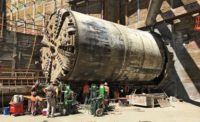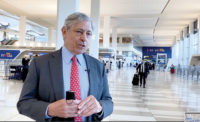Intrepid Tunneling Through a Maze of Gas and Tar in LA
A contracting team is performing a feat once unfeasible—thanks to industry advancements and constant monitoring

Crews completed tunneling through an area full of hazards such as gases, faults, fossils and sticky, unpredictable tar.
Photo courtesy of Traylor Brothers
Tunneling through an urban environment like that of Los Angeles is complex enough. Add to that a medley of poor soils including tar that for millennia sucked in animals to their deaths, creating archaeological conditions; a variety of dangerous gases; and two seismic faults and it becomes a task that until not so long ago was impossible—and even forbidden after an infamous 1985 explosion at a department store.
The once impossible has become reality thanks to a pair of earth pressure balance (EPB) tunnel-boring machines (TBMs), a customized conveyor system, extensive monitoring and political will on the part of owner Los Angeles County Metropolitan Transportation Authority (Metro). A joint venture of Skanska USA Civil, Traylor Brothers Inc. and J.F. Shea Construction completed tunneling last year for its $1.64-billion design-build contract to build the first of three sections of the Los Angeles Metro Purple Line extension, which is on track for a 2025 completion.
“The implementation of EPB TBMs was critical to the project,” says Richard McLane, Traylor chief mechanical engineer. “Further, the three long screw conveyors—which enabled the ventilation to be as close to the screw discharge as possible and encapsulating any gas—were key. The regimented following of the California OSHA Tunnel Safety Orders also played a key role. At no time did the crews become complacent.”
The design-build team, which won the contract to build a nearly four-mile tunnel alignment with 23 cross-passages and three underground stations in 2014, includes Parsons Transportation Group as lead designer and L.K. Comstock National Transit as systems design and installation subcontractor.
The “Westside Subway” Phase 1 will extend the existing Purple Line (recently renamed the D Line) by almost four miles beginning at the Wilshire/Western Station. From this station, the twin tunnel alignment will travel west within the existing, bustling Wilshire Boulevard right-of-way. Underground stations as deep as 80 ft and 1,000 ft long are located at the intersections of Wilshire/La Brea, Wilshire/Fairfax and Wilshire/La Cienega. All three station boxes will be located within the Wilshire Boulevard right-of-way with station portals extending to off-street entrances.
The overall $9.5-billion, nine-mile extension project is part of Metro’s $120-billion, 40-year capital program that intends to improve connectivity and mobility in time for the 2028 Olympics and Paralympic Games. Phase 1 extends the subway line from Koreatown to Beverly Hills underneath the major thoroughfare of Wilshire Boulevard, connecting downtown to Beverly Hills past the historic LaBrea Tar Pits.
In 2019, the Phase 1 project received an Envision Platinum award for sustainable infrastructure—designated by the Institute for Sustainable Infrastructure—in part for aiming to dramatically reduce stormwater runoff. The work included the use of innovative biofiltration and infiltration basins, dry wells and porous pavement.
All three phases of the D Line, as well as two bus rapid transit lines, a light-rail extension and the airport connector, will be ready for 2028, Metro officials say.
D Line Project Pilot Tests Volvo Electric Excavator

Photo courtesy Skanska
Skanska, a member of the contracting team on Los Angeles Metro’s D Line Extension Transit Project, is using a zero-emissions electric excavator on the job as a test pilot. As one of four such pilot programs in North America, Skanska will employ the largest electric excavator of its kind, a Volvo EC230, for a 90-day trial to test its effectiveness on a megaproject.
“The construction industry is responsible for 40% of energy-related carbon emissions,” says James Bailey, executive vice president of Skanska USA Civil’s West Coast operations. “We have worked with innovation leaders and partners—like LA Metro, Sunbelt and Volvo—to share knowledge and resources as we work toward net-zero solutions. Participating in this pilot allows us to continue to be a part of the transition to low-carbon, zero-emission construction. Doing so on a large-scale project like the [D Line] Extension Transit Project will provide a unique insight to inform sustainable innovation moving forward.”
Mason Ford, director of sustainability and equipment services at Skanska USA Civil, says the D Line Extension was the perfect opportunity to test the application of the electric excavator. “We have the need and the demand for the equipment, and we have access to a reliable power source to charge and maintain the efficiency of the battery-powered excavator,” he says. “The Purple Line Extension is also being built in an area that would benefit from the reduction of noise and air pollution that the Volvo EC230 provides.”
During the pilot, the electric Volvo EC230 is temporarily replacing a diesel-powered excavator to load trucks of export material from a stockpile at the South Yard of the La Brea Station. The Volvo has the same capabilities as the 48,000-lb diesel excavator with an 85-gallon fuel capacity and 145 hp gross power. The EC230 uses a Heliox Mobile 50-kW battery, which can charge the vehicle from 0-80% in 3.5 hours.
“The two excavators have essentially the same capacity and workload ability including digging depth and digging reach,” says Ford. “The main difference is that the Volvo EC230 has zero onsite CO2 emissions and is powered by a battery.”
Volvo says the EC230 provides two times noise reduction. This can be particularly helpful on jobsites in the middle of areas like Los Angeles with high population density. And Ford says the change for operators has been “smooth since the machine runs the same as a diesel. The operators don’t need any retraining other than how to charge it.”
Ford says the goal of the pilot is to test the feasibility of zero-emission excavators of this size on megaprojects like the D Line Extension. “Skanska’s role is to use this experiment to improve construction sustainability by supporting the development of advancing technology that, most importantly, is available to contractors and projects of all sizes,” he says. “The success of the pilot is being a part of the process to inform the ongoing transformation of the industry.”
The Volvo EC230 was delivered to D Line jobsite in September and will leave mid-December. The excavator was launched in Europe—where Skanska utilized it on the Slakthusområdet project—and separately in China. The equipment is expected to be available in North America in 2024.
–By Greg Aragon

The overall nine-mile extension of the D Line is part of Metro’s ambitious plan to expand its transit network.
Map courtesy of Metro
*Click on the map for greater detail
History of Risk
The city of Los Angeles had been planning the D Line route since the 1960s. Soil borings were conducted as early as the 1980s, said the Metro team in emailed responses to ENR. “Metro expected high levels of subsurface methane and hydrogen sulfite gases in two of the tunnel reaches and at the Wilshire/Fairfax Station area,” the team stated.
Heavy oil has been seeping up to the surface for centuries, and by the 1930s there were hundreds of wells drilled. In 1985, a methane seep caused a fiery explosion at a Ross Dress for Less store near the pits. As a result, the city designated a high-potential risk zone, and Congress placed a moratorium on federal funding for any tunneling through the area.
In 2005, a panel engaged by the American Public Transportation Association concluded that tunneling along Wilshire Boulevard could be feasible due to advances in gas detection technology and tunneling, and the moratorium was lifted in 2007.
Before awarding the current contracts, Metro geotechnical crews conducted subsurface gas investigations using 63 monitoring wells with gas probes and standpipes that monitored conditions starting in the environmental review stage that will continue until several years after the work is done. Metro also built an exploratory shaft, designed by WSP, near the La Brea Tar Pits that prospective teams could visit.
“Pressurized face TBMs were critical to the project.”
—Dick McLane, Chief Mechanical Engineer, Traylor
The Phase 1 team found large pockets of gas and ultimately extracted 4 million cu ft of gas, says Jeff Brandt, Traylor tunnel construction manager. “We had a robust gas detection system,” he says. Over the course of the tunneling, there were 263 gas detections that required evacuation and the alerting of Cal/OSHA. Typically, it would take 3-4 days to get back to work after such an incident, but thanks to a good relationship with Cal/OSHA, the team could go back to work in an hour or so, says McLane.
The team also found archaeological artifacts such as mastodon bones and dealt with geologic variations of dense sands to silty sands interbedded with layers of silts and clays and the Fernando formation of weakly cemented siltstone/claystone. The largest and most complex of the three major excavations was the La Brea station, which served as the portal from which the TBMs were launched.
The two EPB TBMs provided by Herrenknecht and dubbed Elsie and Soyeon began tunneling in 2018. The twin tunnels are 35,750 linear ft long with inner diameters of 18 ft, 10 in. At the Fairfax station, near the La Brea Tar Pits, the presence of methane and hydrogen sulfite required an extra-large, extra-robust ventilation system operating 24 hours a day to remove contaminated air. Because of the risk to archaeological finds, all excavation for this station took place 6 inches at a time. The TBMs traveled two miles to the east, then were disassembled and returned to Fairfax to tunnel two miles west, says Brandt.
Brandt notes that the water table was just 10 ft below grade. TBM hand mining done under hyperbaric conditions was required in anomalies resulting from groundwater entering the tunnel and creating pressure levels higher than regular atmospheric pressure. Ballard Marine Construction provided hyperbaric chamber operators, compressed air workers and a medical team to oversee work in the cutterhead when water ingress forced the team to apply air pressure.
Elsie and Soyeon were supported by a complex 200-ft-long belt conveyor system that Traylor Brothers designed with Robbins Co. to make the complicated trip up and out of the south shaft. The conveyor system utilizes four types of belts and a three-story vertical storage cassette. Tar sands stuck to the rubber and had to be washed off, stored in a muck pit and hauled away. The system was able to flip to accommodate the TBMs as they excavated eastward before being relaunched.

A pair of 22-ft-dia earth pressure balance machines navigated a treacherous maze of tar, poor soils and dangerous gases.
Photo courtesy of Traylor Bros
Pushing Ahead
A design-build team of Tutor Perini Civil and O&G Industries holds the $1.4-billion contract for Phase 2 to build 2.5 miles of twin tunnels and two stations. In October 2022, the project was halted due to safety concerns resulting from more than 30 incidents from July 2021 to September 2022. Work resumed the following month following a revamped safety plan. Due to other issues, some related to the high property costs associated with Beverly Hills, the Metro board in July authorized an additional $134 million for Phase 2.
The design-build team of Frontier-Kemper and Tutor Perini hold a $410-million contract to build two 2.5-mile-long tunnels for Phase 3, and Tutor Perini leads a design-build team building two stations under a $1.4-billion contract. While high gas conditions are not expected in other areas of the LA Basin, Metro “would likely consider a similar approach [EPB TBMs] if similar ground conditions were identified” for future projects, the team said in an email. The agency would also consider methods such as slurry or variable density machine TBMs in coarser-grained soils, the team added. n




